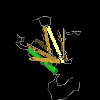?
 
Tandem PH-domain-containing proteins 1 and 2 Pleckstrin homology (PH) domain, N-terminal repeat The binding of TAPP1 (also called PLEKHA1/pleckstrin homology domain containing, family A (phosphoinositide binding specific) member 1) and TAPP2 (also called PLEKHA2) adaptors to PtdIns(3,4)P(2), but not PI(3,4, 5)P3, function as negative regulators of insulin and PI3K signalling pathways (i.e. TAPP/utrophin/syntrophin complex). TAPP1 and TAPP2 contain two sequential PH domains in which the C-terminal PH domain binds PtdIns(3,4)P2. They also contain a C-terminal PDZ-binding motif that interacts with several PDZ-binding proteins, including PTPN13 (known previously as PTPL1 or FAP-1) as well as the scaffolding proteins MUPP1 (multiple PDZ-domain-containing protein 1), syntrophin and utrophin. PH domains have diverse functions, but in general are involved in targeting proteins to the appropriate cellular location or in the interaction with a binding partner. They share little sequence conservation, but all have a common fold, which is electrostatically polarized. Less than 10% of PH domains bind phosphoinositide phosphates (PIPs) with high affinity and specificity. PH domains are distinguished from other PIP-binding domains by their specific high-affinity binding to PIPs with two vicinal phosphate groups: PtdIns(3,4)P2, PtdIns(4,5)P2 or PtdIns(3,4,5)P3 which results in targeting some PH domain proteins to the plasma membrane. A few display strong specificity in lipid binding. Any specificity is usually determined by loop regions or insertions in the N-terminus of the domain, which are not conserved across all PH domains. PH domains are found in cellular signaling proteins such as serine/threonine kinase, tyrosine kinases, regulators of G-proteins, endocytotic GTPases, adaptors, as well as cytoskeletal associated molecules and in lipid associated enzymes. |
